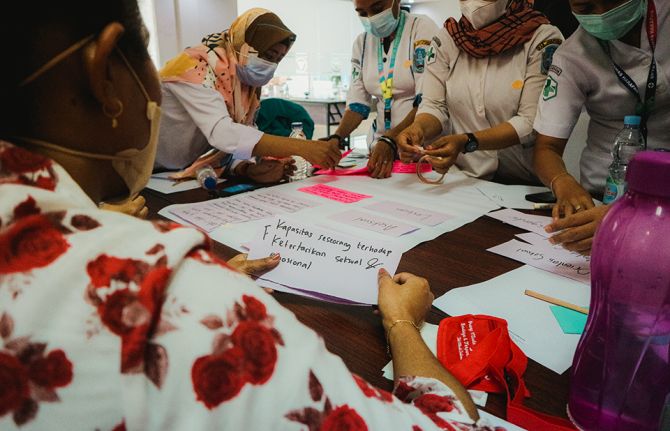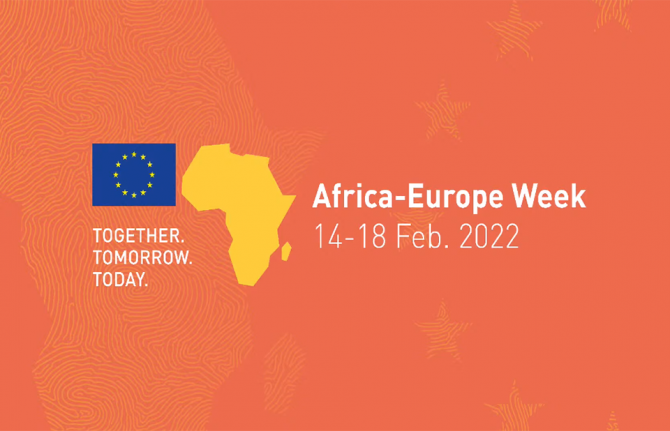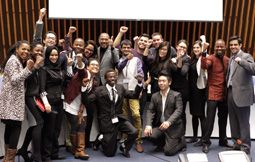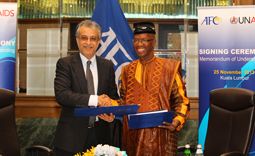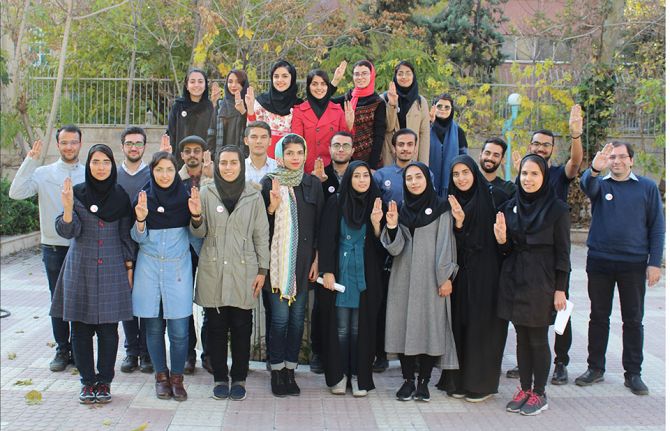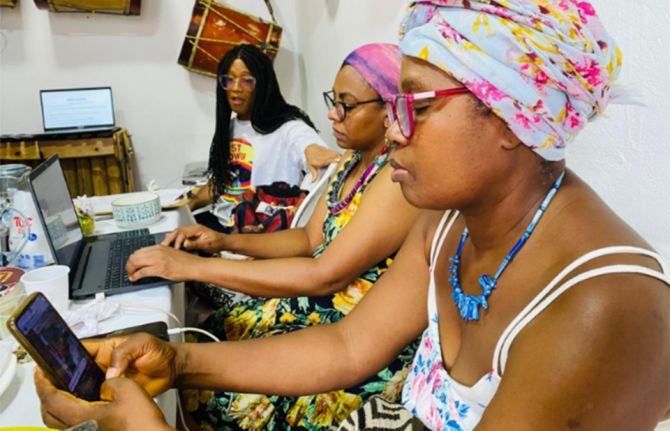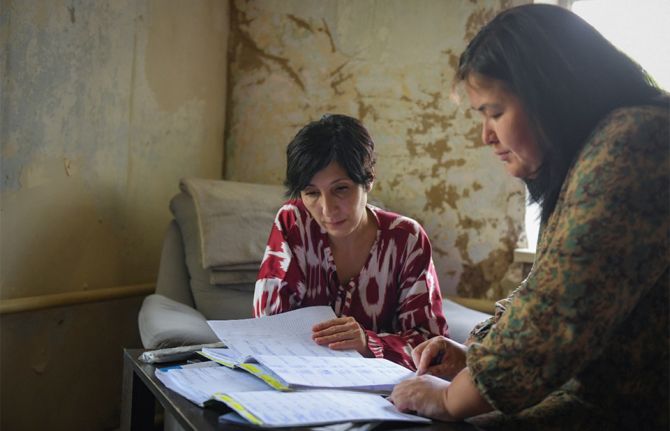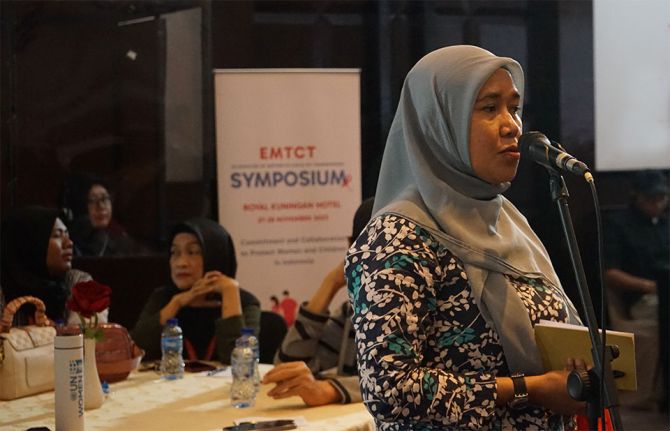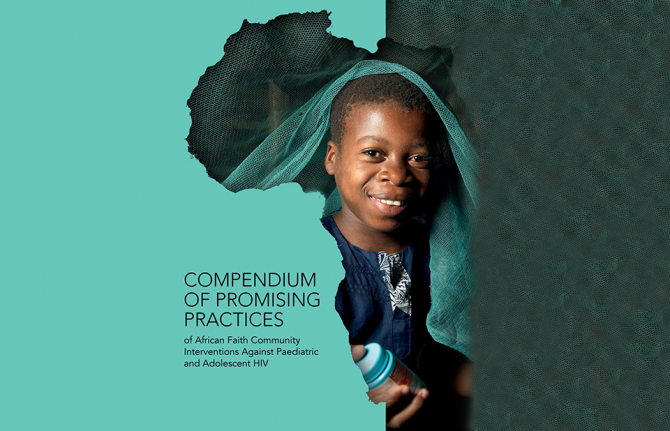
Feature Story
Can MDG 6 be achieved with the Health Workforce we have?
09 June 2011
09 June 2011 09 June 2011
Credit: AMREF
If international aims such as achieving health-related Millennium Development Goals (MDGs) and universal access to HIV services are to be realized, the serious global shortage of health workers must be urgently addressed. This shortage has been severely exacerbated by the AIDS epidemic reducing staff numbers and significantly increasing the workload of those remaining.
At a side event during the High Level Meeting on AIDS in New York this week, the need to recognise human resources as a crucial element in the global AIDS response was explored in depth. Without sufficient human resources, countries' efforts to scale up comprehensive AIDS services will not be sustained, making it impossible to reach the MDGs.
The meeting, Can MDG 6 be achieved with the Health Workforce we have?, was jointly organized by the Global Health Workforce Alliance (GHWA), along with the Government of Brazil, the Commonwealth Secretariat, UNAIDS and the African Medical and Research Foundation (AMREF).
A lively panel discussion, including heads of state, senior representatives from donor and international organisations, civil society and the private sector, examined the interconnectivity of HIV and human resources and also shared best practices.
Joining discussants Mphu Ramatlapeng, both Global Fund Vice-chair and Lesotho’s Health Minister and Secretary Jarbas Barbosa, Brazil’s Secretary of Health Surveillance, were keynote speakers Dileita Mohamed Dileita, Prime Minister of Djibouti and Maxensia Nakibuuka, a Ugandan community health worker living with HIV. The session was moderated by Pulitzer prize-winning journalist Laurie Garrett, who is also Senior Global Health Fellow at the Council on Foreign Relations research centre.
Mr Dileita Mohamed Dileita highlighted the effects of an insufficient number of health workers, their uneven distribution, and limitations in their competencies in his own country, Djibouti. Dr Barbosa agreed that uneven distribution of staff is a major problem in Brazil.
Speaking as a community health worker Maxensia Nakibuuka from Uganda emphasized the difficulties she and her colleagues faced, “We are left to do it alone. Without system strengthening, without budgets; with nothing…We need to be recognized.”
According to Mphu Ramatlapeng, the Global Fund is helping countries meet their needs, with round 11 of Fund proposals including support for health workforce strengthening. She also stressed the crucial need for all stakeholders to work together.
The role of the private sector in offering support was examined. Michael Bzdak, Johnson & Johnson ‘s Director of Contributions and Community relations, spoke of their corporate social responsibility and building health care capacity, primarily in terms of leadership, management techniques and skills training.
Dr Sigrun Mogedal, former-Ambassador, HIV/AIDS and Global Health Initiatives, Norway, and former Chair of the GHWA board, commented on the need to “do things differently.” She referred to the recently released Alliance taskforce report Will we achieve universal access to HIV/AIDS services with the health workforce we have? A snapshot from five countries and stressed actions required by governments and other decision makers. These include: estimating numbers and types of health workers needed to reach international targets; strengthening health workforce management systems; implementing costed plans for increasing and improving the health workforce; and scaling up successful approaches.
Another important aspect raised was the need to focus considerable attention not only on workforce training but on staff retention strategies, looking at motivation and job satisfaction. This point was made by Dr John Palen, Senior HRH advisor of the US President’s Emergency Plan for AIDS Relief (PEPFAR).
The answer to the central question posed was a sobering one: if the impact of AIDS on health workers is not seriously addressed, the human resources crisis will worsen and MDG 6 will become almost impossible to attain. Although progress is being made, there are still many gaps and challenges to overcome.
A report of the meeting will be made available shortly.
Related

Feature Story
New world report on disability: Breaking down barriers
09 June 2011
09 June 2011 09 June 2011
Credit: WHO
The world’s one billion people living with disabilities have poorer health, lower educational achievements and are more prone to social exclusion than those without disabilities. Launched 9 June, the first ever World Report on Disability challenges these disparities and suggests how they can be overcome.
The launch event, which took place during the High Level Meeting on AIDS in New York, was hosted by World Health Organization (WHO) Director-General Dr Margaret Chan and World Bank Vice President Tamar Manuelyan Atinc. The report is produced by both organizations and the two heads were joined by other dignitaries and by representatives of government and civil society.
The publication is a global call to action and assists implementation of the groundbreaking international treaty, the Convention on the Rights of Persons with Disabilities, which was adopted in May 2008. Concerned with national, regional and global policy, it also includes the perspectives of many people who are living with disabilities. In addition, it features the first new disability prevalence estimates for more than three decades: it contends that prevalence is likely to rise in the future due, in part, to the increase in chronic diseases and ageing populations.
We must do more to break the barriers which segregate people with disabilities, in many cases forcing them to the margins of society
Dr Margaret Chan, Director-General, World Health Organization
During the launch event the speakers described the difficulties people with disabilities face, including barriers to accessing health, education, employment and information services.
According to Dr Chan, "Disability is part of the human condition. Almost every one of us will be permanently or temporarily disabled at some point in life. We must do more to break the barriers which segregate people with disabilities, in many cases forcing them to the margins of society."
UNAIDS Executive Director Michel Sidibé called for “an end to all discrimination and inequity faced by people living the disabilities, which not only rob people of their dignity, but block their access to HIV prevention, treatment, care and support.”
HIV and people with disabilities
According to the UNAIDS, WHO and OHCHR policy brief on HIV and disability people with disabilities may be at risk of HIV infection due to a number of reasons, including insufficient access to appropriate HIV prevention and support services, and their higher risk of experiencing sexual assault or abuse during their lifetime. They may also be turned away from HIV education forums or not be invited by outreach workers, because of assumptions that they are not sexually active, or do not engage in other risk behaviours such as injecting drugs.
There must be an end to all discrimination and inequity faced by people living the disabilities, which not only rob people of their dignity, but block their access to HIV prevention, treatment, care and support
Michel Sidibé, UNAIDS Executive Director
The new report gives examples of the issues and situation concerning HIV and people with disabilities. A survey commissioned by the Zimbabwe Parents of Handicapped Children’s Association demonstrated that hearing and visually impaired people were excluded from HIV services because they were not offered in sign language or Braille. On the other hand, there are many examples throughout the report of how individuals, organizations, countries and regions are promoting good practice.
The goal of the World Report on Disability is to provide information and strategic guidance to key actors, such as policy makers, donors and practitioners. A series of recommendations include: investing in specific programmes and services for people with disabilities; adopting a national strategy and action plan; involving people with disabilities in policy and planning decisions and raising public awareness and understanding.
External Links
External links
Publications
Publications
- World report on disability (WHO/World Bank, 2011)
- Disability and HIV policy brief
Multimedia
Multimedia
Related
 Building country-led sustainable HIV responses
Building country-led sustainable HIV responses

20 December 2024
 Towards a life of dignity for people living with disabilities
Towards a life of dignity for people living with disabilities

15 February 2022

Feature Story
It’s possible: Making the most of linking sexual and reproductive health and HIV responses
09 June 2011
09 June 2011 09 June 2011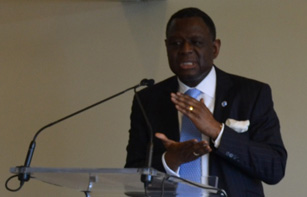
Dr Babatunde Osotimehin.
Credit: UNFPA
Linking sexual and reproductive health and HIV is of critical importance. Worldwide more than 80% of HIV infections are sexually transmitted. In addition, sexual and reproductive ill health and HIV are fueled by similar causes such as poverty, limited access to services, lack of correct information, gender inequality and social marginalization.
On 8 June, during a side event at this week’s General Assembly High Level Meeting on AIDS in New York, the question of how exactly such linkages can be strengthened was explored. The event was sponsored by UNAIDS, the UN Educational, Scientific and Cultural Organization (UNESCO), the UN Population Fund (UNFPA), the World Health Organization (WHO), and the International Planned Parenthood Federation (IPPF).
The highly interactive session looked at the issue through the prism of five key thematic areas: cost-effectiveness and cost savings of linkages; prevention of mother to child transmission though a sexual and reproductive health platform; comprehensive sexuality education for young people; ending gender-based violence; and human rights of people living with HIV.
Making ‘people-sense’
In his opening remarks, Dr Babatunde Osotimehin, UNFPA Executive Director, explained how the integration of sexual and reproductive health and HIV services makes ‘people-sense’. These services include testing for HIV and other sexually transmitted infections, prevention of mother-to-child transmission, support for fertility decisions, and access to condoms, contraception and correct information. He went on to emphasize wider policy and human rights implications.
“Linking sexual and reproductive health and HIV goes beyond integrating health services,” he said. “It demands from us that we fortify the human rights platform–ending stigma, violence and discrimination.”
Human rights and the right to health were said to be at the core of greater integration of services. A broader human rights agenda can also be promoted that goes beyond service delivery and tackles legal reforms, such as those relating to the right to information and freedom from violence, abuse and coercion.
Sharing ideas and experience
The participants shared ideas and experiences of how those working in the fields of HIV and sexual and reproductive health have combined their efforts to make interventions more effective in creative and innovative ways, including strategies to strengthen treatment as a prevention option.
It was stressed that mother- and child-centred care can improve both sexual and reproductive health and HIV outcomes. For many women, pregnancy is the first point of access in the health system and they can benefit from a range of interventions, including HIV prevention and treatment integrated into routine maternal health care; family planning; and preventing and managing sexually transmitted infections and gender-based violence.
The discussion also showed that when comprehensive sexuality education is effectively implemented on a national scale, there is potential for cost saving from averting HIV infections, other STIs and unintended pregnancies.
Participants examined how men can benefit from greater integration. For instance, in countries where voluntary male circumcision is being implemented for HIV prevention, the number of men accessing other sexual and reproductive services, such as prevention of mother-to-child transmission and treatment of STIs, has increased.
The meeting closed with agreement that linking sexual and reproductive health and the HIV response, especially in a climate of austerity, is a gateway to strengthening both the human rights agenda and health systems.
External links
Related

Feature Story
High level panel highlights need for greater investments in technology and innovation to advance results for HIV prevention for treatment
10 June 2011
10 June 2011 10 June 2011
Ratu Epeli Nailatikau, President of the Republic of Fiji, chairs the panel discussion on Innovation and new technologies, 9 June 2011. Credit: UN Photo/Paulo Filgueiras
Progress in reducing the number of new HIV infections and increasing access to antiretroviral treatment over the past three decades did not happen haphazardly but were in large part due to a concerted international effort that bridged technology and innovation for results in HIV prevention and treatment.
This emerged from an official panel entitled Innovation and new technologies, one of five panels in which high level representatives from member states and civil society are holding as part of the 2011 United Nations General Assembly High Level Meeting on AIDS.
Chaired by HE President Ratu Epeli Nailatikau of Fiji, the panel brought together the Director-General of the World Health Organization, Dr Margaret Chan; the Minister of Health of Mexico, Dr Jose Angel Cordova Villalobos; and Dr Christoforos Mallouris, Director of Programmes, Global Network of People Living with HIV (GNP+).
The panellists shared their insights on how technology and innovation have played instrumental roles in helping realize the results achieved in the AIDS response to date. One example cited was the increase in the past decade of the number of people living with HIV on antiretroviral treatment: in 2010 that figure stood at 6.6 million up from 240 000 in 2001. Cited as central to this unprecedented development was a combination of innovative technology that led to highly effective antiretroviral medicines and improved access to that technology through the availability of low-cost, quality-assured drugs.
Doing more of the same is not enough. We need innovation urgently.
World Health Organization Director-General Dr Margaret Chan
“Collaboration with developing countries will be crucial," said President Nailatikau who highlighted the need to find innovative solutions at the heart of the disease. “With this, we have a chance to make a huge impact against one of the greatest health and development challenges of our generation.”
Moderated by British journalist Andrew Jack from the Financial Times, the discussion focused substantially on the several challenges facing the AIDS response from the technology and innovation perspective, mainly the necessity to urgently expand access to newer and improved HIV technologies, such as better diagnostics for CD4 and viral load counts, and increased investments in biomedical prevention technologies such as microbicides.
The panellists agreed that access to proven HIV prevention technologies—from male and female condoms to male circumcision—must continue to be scaled up and governments should ensure policies are in place within their national responses that foster innovation and advancement, from both the public and private sector. Innovative partnerships that create financial or other incentives to spur research and development were viewed as key elements.
“Let’s not let the pace of the epidemic get beyond us. We have the capacity for innovation to recreate ourselves to achieve not only zero new infections, zero discrimination and zero AIDS-related deaths; but also for zero homophobia and transphobia, zero gender-discrimination and human rights for all,” said President Felipe Calderón of Mexico,
Echoing a “positive health, dignity and prevention” approach, Dr Mallouris of GNP+ urged for greater involvement of people living with HIV in prevention. “People living with HIV also need prevention and new prevention technologies. We need to ensure that people living with HIV are involved—we are not just vessels of transmission, we want prevention too,” said Dr Mallouris.
The panel also drew attention to the recent results of the HPTN 052 study announced by the United States National Institutes of Health which demonstrated that if an HIV-positive person adheres to an effective antiretroviral therapy regimen, the risk of transmitting the virus to their uninfected sexual partner can be reduced by 96%. Attention was also given to the ongoing search for an HIV vaccine that, although estimated to be decades away, is considered by many in the AIDS community as an essential component of the future AIDS response.
“Doing more of the same is not enough,” said World Health Organization Director-General Dr Chan. “We need innovation urgently and we are still running behind this devastating epidemic. We know now…beyond doubt that early treatment has a powerful effect on transmission in sero-discordant couples—we must maximize the preventive effects of treatment by early diagnosis.”
However in both the short- and medium-term, the panel stressed the importance of rapidly expanding access to antiretroviral treatment as one of the most pressing issues. With about nine million people in low- and middle-income countries who are eligible for treatment in need, the panel encouraged countries to give priority to transferring research and technology as well as to provide sufficient funding for the research and development of safer, more effective antiretroviral medicines that are also easier to use.
UN General Assembly High Level Meeting on AIDS
Thirty years into the AIDS epidemic, and 10 years since the landmark UN General Assembly Special Session on HIV/AIDS, the world has come together to review progress and chart the future course of the global AIDS response at the 2011 UN General Assembly High Level Meeting on AIDS from 8–10 June 2011 in New York. Member States are expected to adopt a new Declaration that will reaffirm current commitments and commit to actions to guide and sustain the global AIDS response.
External links
External links
Multimedia
Multimedia
Publications
Publications
- Backgrounder Panel 3: Innovation and new technologies (pdf, 160 Kb)
Related

Feature Story
A sustainable HIV response: New global health sector strategy to help chart the way forward
23 May 2011
23 May 2011 23 May 2011
The World Health Assembly today adopted a new comprehensive Global Health Sector Strategy for HIV/AIDS 2011-2015, spearheaded by the World Health Organization (WHO). The strategy aims to provide a detailed and comprehensive guide to how health sectors can most effectively tackle the epidemic.
Recognizing that the nature of the epidemic has evolved in recent years, and that the AIDS response has to be dynamic and flexible, the World Health Assembly in 2010 called for a new HIV strategy to inform global health sector action. In consultation with some 100 member states, civil society and other key players, a number of whom participated online; a strategy has been formulated which takes into account great strides made in the AIDS response and maps out what needs to be done in the future.
The latest UNAIDS global report has shown that the AIDS epidemic has been halted and that the spread of HIV is beginning to be reversed. New infections have fallen by almost 20% in the last 10 years and between 2003 and 2009 there was a 13-fold increase in treatment coverage. However, in 2009 only a third of people in need of treatment received it and the demand for resources is still outstripping supply.
The new Global Health Sector Strategy for HIV/AIDS, which is fully aligned with, and complements, the UNAIDS strategy 2011-15, Getting to Zero, will operate within this changed landscape to optimize progress towards universal access and the attainment of the Millennium Development Goals. It promotes tailored responses to national and regional epidemics and analyzes the underlying socio-economic and cultural determinants contributing to the spread of the virus.
The strategy seeks to reduce vulnerability and structural barriers to accessing good quality services. It also demonstrates how HIV programmes can play a role in broader health outcomes and recognizes the importance of strong health and community systems to guarantee a sustainable response.
WHO will make five key contributions to the Global Health Sector Strategy:
- Scale up innovation in prevention
- Optimize treatment and care
- Support health for women and children
- Promote strategic health-sector information and planning
- Provide leadership in addressing health equity and HIV (examining inequities in access to HIV services)
The new strategy represents another significant step forward in the global response to HIV.
External links
External links
Publications
Related

Feature Story
New draft AIDS strategy high on the World Health Assembly agenda
16 May 2011
16 May 2011 16 May 2011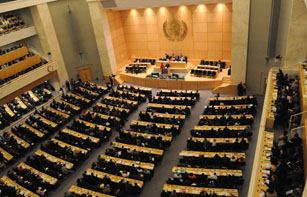
Credit: WHO/Oliver O'Hanlon
The full adoption of the new draft World Health Organization (WHO) global health strategy for HIV 2011-2015 will be a key focus of discussion at the 64th World Health Assembly, taking place in Geneva from 16-24 May and attended by Health Ministers and officials from more than 190 countries. Intended as a global call to action, the comprehensive draft strategy maps out the WHO latest guidance and approaches to successfully challenging today’s evolving AIDS epidemic.
The World Health Assembly, the highest decision-making body of the World Health Organization which sets policy and approves the budget, will also debate a multiplicity of other issues. These include: pandemic influenza preparedness, cholera and the mechanism for control and prevention, infant and young child nutrition, youth and health risks, safe management of drinking water, climate change and health prevention and control of non-communicable diseases and malaria. The future of financing for WHO will also be high on the agenda.
Today WHO Director-General Dr Margaret Chan will address the Assembly and on 17 May invited speakers Mrs Sheikh Hasina, Prime Minister of Bangladesh, and Bill Gates, Co-chair of the Bill & Melinda Gates Foundation, will take the floor.
Four technical meetings, ranging from public health concerns and radiation health to information and accountability for the health of women and children are also scheduled.
In addition to setting policy, the Assembly will give the gathered government representatives, medical professionals and academics the chance to exchange ideas and experiences. Regional meetings for Ministers of Health are set to provide an opportunity to explore specifically relevant issues.
External links
External links
Related

Press Release
Groundbreaking trial results confirm HIV treatment prevents transmission of HIV
12 May 2011 12 May 2011WHO and UNAIDS hail results from the HPTN 052 trial that show antiretroviral therapy to be 96% effective in reducing HIV transmission in couples where one partner has HIV
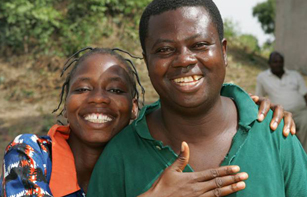
Credit: UNAIDS/P.Virot.
GENEVA, 12 May 2011—Results announced today by the United States National Institutes of Health show that if an HIV-positive person adheres to an effective antiretroviral therapy regimen, the risk of transmitting the virus to their uninfected sexual partner can be reduced by 96%.
“This breakthrough is a serious game changer and will drive the prevention revolution forward. It makes HIV treatment a new priority prevention option,” said Michel Sidibé, Executive Director of the Joint United Nations Programme on HIV/AIDS (UNAIDS). “Now we need to make sure that couples have the option to choose Treatment for Prevention and have access to it.”
The trial, conducted by the HIV Prevention Trials Network, enrolled more than 1 700 sero-discordant couples (one partner who is HIV-positive and one who is HIV-negative) from Africa, Asia, Latin America and the United States of America.
Only people living with HIV with a CD4 cell count of between 350 and 550, thus not yet eligible for treatment for their own health according to latest WHO guidelines, were enrolled in the study. The reduction of sexual transmission of HIV was so significant that the trial was stopped 3-4 years ahead of schedule.
"This is a crucial development, because we know that sexual transmission accounts for about 80% of all new infections," said Dr Margaret Chan, WHO Director-General. "The findings from this study will further strengthen and support the new guidance that WHO is releasing in July to help people living with HIV protect their partners."
The availability of Treatment for Prevention will not only empower people to get tested for HIV, but also to disclose their HIV status, discuss HIV prevention options with their partners and access essential HIV services. It will also significantly contribute to reducing the stigma and discrimination surrounding HIV.
“People living with HIV can now, with dignity and confidence, take additional steps to protect their loved ones from HIV,” said Mr Sidibé.
It is currently estimated that only about half of the 33 million people living with HIV know their HIV status. An increase in the uptake of testing for HIV would have a significant impact on the AIDS response, particularly if more people gain access to treatment in light of the new findings.
UNAIDS and WHO recommend that couples make evidence-informed decisions on which combination of HIV prevention options is best for them. UNAIDS urges that Treatment for Prevention be one of the options made available to couples. The new WHO guidelines coming out in July will help countries to make this a reality for people who choose to use this new HIV prevention option. The guidelines will include specific recommendations on increasing access to HIV testing and counseling and the use of antiretroviral therapy among discordant couples.
No single method is fully protective against HIV. Treatment for Prevention needs to be used in combination with other HIV prevention options. These include correct and consistent use of male and female condoms, waiting longer before having sex for the first time, having fewer partners, male circumcision, and avoiding penetrative sex. The significance of the findings put Treatment for Prevention firmly in the HIV prevention package.
To increase access to the Treatment for Prevention option, the Treatment 2.0 initiative must be urgently implemented to innovate, simplify, reduce costs and mobilize communities to scale up HIV testing and counseling and treatment.
UNAIDS will convene a partners meeting to further discuss this new development and its implications for the AIDS response. This builds on a series of expert consultations which have been convened by UNAIDS and WHO on Treatment for Prevention during the last two years.
UNAIDS and WHO will work with countries and partners to make Treatment for Prevention an integral part of the HIV response and to ensure it is made available to people who wish to use it as soon as possible.
Contact
UNAIDS GenevaSophie Barton-Knott
tel. +41 22 791 1697
bartonknotts@unaids.org
WHO Geneva
Tunga Namjilsuren
tel. +41 22 791 1073
namjilsurent@who.int
Press centre
Download the printable version (PDF)

Feature Story
New monitoring centre helps tackle HIV in prisons in Latin America and the Caribbean
20 April 2011
20 April 2011 20 April 2011
Observatorio VIH y Cárceles de LatinoaMÉrica y el Caribe
Mounting an effective challenge to HIV in prison settings is a key part of the AIDS response at national, regional and global levels. To define standards for HIV prevention and treatment and the protection and promotion of prisoners’ human rights, it is important to consolidate as much data as possible about the epidemic in this environment. The newly established Monitoring Centre for HIV and Prisons in Latin America and the Caribbean is set to become the key regional repository for such vital information.
The Monitoring Centre—called the Observatorio VIH y Cárceles de LatinoaMÉrica y el Caribe in Spanish—gathers data from 23 countries which is accessible via a web site. Its primary aim is to help governments and civil society define and implement national HIV prison policies based on international standards. Up and running in Spanish since mid-February, an English language version will be launched 30 April 2011.
The United Nations Office on Drugs and Crime (UNODC) is spearheading the initiative with support from the UN Educational, Scientific and Cultural Organisation (UNESCO), the Pan American Health Organization (PAHO), the World Bank, the UN Development Programme (UNDP) and UNAIDS.
According to José Vila del Castillo, UNODC Regional Advisor, “The Monitoring Centre shows the United Nations system ‘delivering as one’. Addressing HIV in the region’s prisons has become a priority. The centre is an important tool to catalyze prison reform processes and HIV penitentiary programmes.”
Addressing HIV in the region’s prisons has become a priority. The centre is an important tool to catalyze prison reform processes and HIV penitentiary programmes
José Vila del Castillo, UNODC Regional Advisor
Providing a permanent public space for informed reflection and dialogue, the virtual centre develops methodologies for collecting, processing, analysing and validating the scientific data gleaned on what works, and how best to proceed, in addressing HIV in prisons. It will highlight existing information and encourage ongoing research. Training and technical support are also offered through reference directories, online consultations, discussion forums and virtual classrooms.
In Latin America and the Caribbean, as elsewhere, many prisoners are vulnerable to HIV due to a number of factors, including the relative lack of knowledge about the virus among this population, overcrowding, lack of access to protection and good quality health services and violent conditions.
Across the region, where data are available, several countries have higher HIV prevalence in the prison population than in the general population. For example, according to data collected by UNODC this year, in Peru there are more than eight times as many people living with HIV in prison than outside (4.03% versus 0.4%). In Bolivia the situation is even starker; the same source documents show that in nine prisons in the country, 10% of prisoners are reported as HIV positive, compared to 0.2% prevalence in the wider society.
César Antonio Núñez, Director of UNAIDS’ Latin America Regional Support Team, believes the Monitoring Centre will provide a valuable insight into the lives of a neglected population, “The Centre will really help us to know the true HIV situation in the penitentiary system, and shed light on human rights-related issues. It is probably in the environment of HIV and prisons where UNAIDS’ commitment to being ‘the voice of the voiceless’ is most needed and appropriate.”

Feature Story
World Health Day 2011: Urgent action necessary to slow down the spread of drug resistance
07 April 2011
07 April 2011 07 April 2011A version of this story also appears at who.int
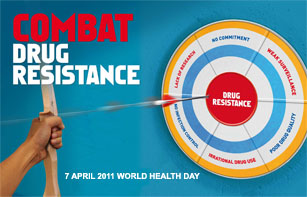
Credit: WHO
Drug resistance is becoming more severe and many infections are no longer easily cured, leading to prolonged and expensive treatment and greater risk of death, warns the World Health Organization (WHO) on World Health Day, 7 April 2011.
Under the theme "combat drug resistance", WHO calls for urgent and concerted action by governments, health professionals, industry, civil society and patients to slow down the spread of drug resistance, limiting its impact today and preserving medical advances for future generations.
Drug resistance is a natural process in which microorganisms acquire resistance to the drugs meant to kill them. With each new generation, the microorganism carrying the resistant gene becomes ever more dominant until the drug is completely ineffective. Inappropriate use of infection-fighting drugs (underuse, overuse or misuse) causes resistance to emerge more quickly.
On the brink of losing miracle cures
The trends are clear and ominous. No action today means no cure tomorrow
WHO Director-General Dr Margaret Chan
“The message on this World Health Day is loud and clear. The world is on the brink of losing these miracle cures,” said WHO Director-General Dr Margaret Chan. She added, “The trends are clear and ominous. No action today means no cure tomorrow.”
Measures to combat drug resistance
WHO has published a policy package that sets out the measures governments and their national partners need to combat drug resistance. These include:
- Develop and implement a comprehensive, financed national plan
- Strengthen surveillance and laboratory capacity
- Ensure uninterrupted access to essential medicines of assured quality
- Regulate and promote rational use of medicines
- Enhance infection prevention and control
- Foster innovation and research and development for new tools.
Resistance detected in a number of diseases
According to latest WHO figures, at least 440 000 of new cases of multidrug resistant-tuberculosis (MDR-TB) emerge each year, and by the end of 2010, 69 countries had reported extensively drug-resistant tuberculosis (XDR-TB). Resistance is also emerging to the antiretroviral drugs used to treat people living with HIV.
Getting everyone on the right track
Dr Mario Raviglione, Director of WHO Stop TB Department, who has been leading the preparations for World Health Day 2011, called for measures against drug resistance to be strengthened and implemented urgently. He added, “New collaborations, led by governments working alongside civil society and health professionals, if accountable, can halt the public health threat of drug resistance."
External links
External links
Related

Feature Story
Top 30 medicines to save mothers and children identified by the World Health Organization
29 March 2011
29 March 2011 29 March 2011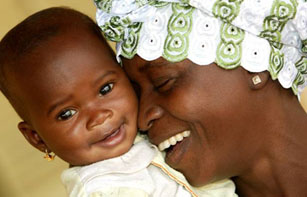
Credit: UNAIDS/P. Virot
The World Health Organization (WHO) has published its first ever list of 30 priority medicines for maternal and child health. The list includes medicines for children living with HIV as well as a triple combination of drugs to prevent mother-to-child transmission of HIV.
Compiled by experts in maternal and child health and medicines, the list is based on the WHO Model List of Essential Medicines and the latest WHO treatment guidelines. It provides a concrete way forward in striving to achieve global health goals[i].
The health situation for many women and children across the globe remains precarious. Despite a decline since 2004, in 2009 an estimated 260 000 children under the age of 15 died from AIDS-related illness[ii]. Every day some 1000 women lose their lives due to complications during pregnancy and childbirth. Most of these deaths can be prevented if the correct medicines in the correct formulations are prescribed and used in the correct way.
Many of the medicines can be administered quickly and easily. For example, a single injection of oxytocin can stop a woman bleeding to death if she haemorrhages after childbirth.
Preventing mother-to-child transmission of HIV
The WHO-recommended drug regimen of prolonged use of combination of three antiretroviral (ARV) drugs to prevent mother-to-child transmission of HIV is also highlighted in the priority medicines list.
Positive results from a WHO-led study that were published in The Lancet in January 2011 showed that giving pregnant women living with HIV a combination of three ARV drugs during the last trimester of pregnancy, through delivery and six months of breastfeeding can reduce the risk of their baby being infected with HIV by more than 40% compared to the use of a single-dose ARV drug regimen which stopped at delivery as had been recommended by WHO since 2004.
Children and HIV
Without effective HIV treatment, an estimated one third of infants living with the virus will have died by one year of age, and about half will have died by two years of age. The list includes recommendations in the area of paediatric AIDS. Appropriate doses of the right combinations of antiretrovirals are critical to reducing child deaths from AIDS-related illness.
According to WHO, additional research and development is also urgently needed for appropriate products for prevention and treatment of tuberculosis, particularly in children living with HIV.
This list is designed to help countries prioritize, so that they focus on getting the most critical things available and save the most lives
Dr Elizabeth Mason, Director of WHO's Department of Maternal, Newborn, Child and Adolescent Health
Despite these pressing needs, surveys conducted in 14 African countries show that children's medicines are available in only 35% to 50% of pharmacies and drug stores[iii]. There is also a lack of awareness that children need different medicines from adults. When adult medicines are fractioned into smaller parts for children, the dose can be inaccurate and the medicine hard to swallow.
WHO recommends that, wherever possible, medicines for children should be provided in doses that are easy to measure and easy to take. There should also be steps to ensure that medicines are appropriate for the intended setting.
"Medicines produced in liquid form are more expensive than tablets or powders and are also more difficult to store, package, and transport, due to their bulk, weight and need for refrigeration. The list we have drawn up tells manufacturers exactly what they should be producing to meet countries’ needs," said Dr Hans V. Hogerzeil, Director of WHO's Department for Essential Medicines and Pharmaceutical Policies.
The release of the list of top 30 medicines to save mothers and children was timed to coincide with the meeting of the 18th Expert Committee on the Selection and Use of Essential Medicines. The meeting took place in Ghana, 21-25 March 2011. “This list is designed to help countries prioritize, so that they focus on getting the most critical things available and save the most lives," said Dr Elizabeth Mason, Director of WHO's Department of Maternal, Newborn, Child and Adolescent Health.
[i] Millennium Development Goals 4, 5 & 6: Reduce child mortality; Improve maternal health; Combat HIV/AIDS, malaria and other diseases.
[ii] UNAIDS global report 2010
[iii] Jane Robertson, Gilles Forte, Jean-Marie Trapsida & Suzanne Hill. What essential medicines for children are on the shelf? Bulletin of the World Health Organization 2009;87:231-237. doi: 10.2471/BLT.08.053645



